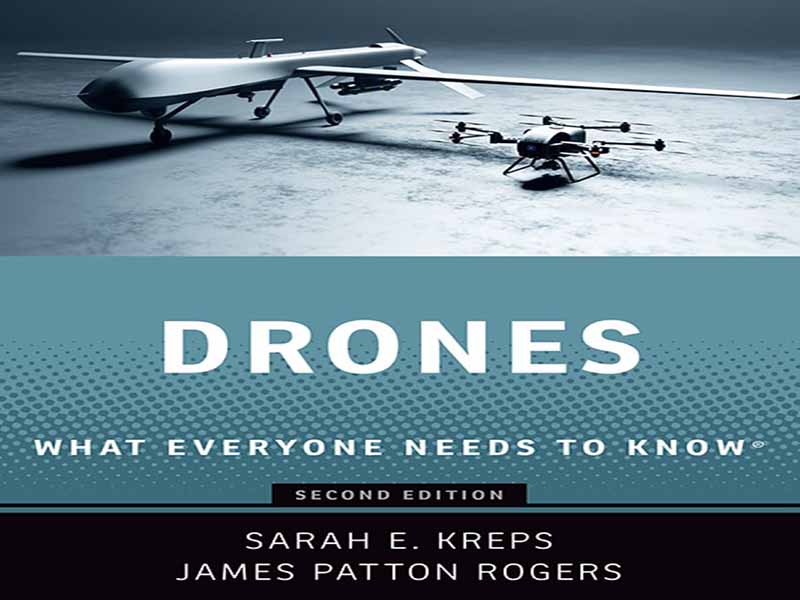- عنوان کتاب: DRONES -WHAT EVERYONE NEEDS TO KNOW
- نویسنده: Sarah E. Kreps, James Patton Rogers
- حوزه: پهپاد
- سال انتشار: 2025
- تعداد صفحه: 288
- زبان اصلی: انگلیسی
- نوع فایل: pdf
- حجم فایل: 4.49 مگابایت
اصطلاح «پهپاد» به طور کلی به وسایل نقلیه هوایی بدون سرنشین یا بدون سرنشین (UAV) اطلاق میشود. با این وجود، اصطلاحات مورد استفاده و تعاریف اتخاذ شده میتواند بین سازمانها متفاوت باشد. اداره هوانوردی فدرال ایالات متحده (FAA) از پهپاد به عنوان «سیستم هواپیمای بدون سرنشین» (UAS) یاد میکند، در حالی که نیروی هوایی ایالات متحده به بزرگترین پهپادهای خود «هواپیمای هدایتشونده از راه دور» (RPA) میگوید. سازمان دوم ترجیح میدهد کلمه «خلبان» را به دلیل آموزش قابل توجهی که حتی برای یک اپراتور مستقر در موقعیت از راه دور مورد نیاز است، بگنجاند. همچنین تأکید میکند که یک انسان در حلقه کنترل، هرچند از راه دور، وجود دارد. همه این نامها به ویژگیای اشاره دارند که پهپادها را متحد میکند: اینکه آنها بدون خلبان در هواپیما کار میکنند. با این حال، وسایل نقلیه هوایی مختلف دیگر – از جمله موشک، راکت، بالن یا کایت – خلبان در هواپیما ندارند. پس پهپادها چه تفاوتی دارند؟ FAA مطابق با نامگذاری UAS خود، به طور خاص پهپاد را به عنوان «یک هواپیمای بدون سرنشین و تجهیزات لازم برای عملکرد ایمن و کارآمد آن هواپیما» تعریف میکند. با در نظر گرفتن سختافزار و ابزار کنترل، اداره هوانوردی فدرال (FAA) در ادامه اظهار میکند که «یک هواپیمای بدون سرنشین، جزئی از یک UAS است. طبق قانون، این هواپیما به عنوان هواپیمایی تعریف میشود که بدون امکان مداخله مستقیم انسان از داخل یا روی هواپیما اداره میشود.»3 به عبارت ساده، نکات کلیدی در تعریف FAA شامل جزء پروازی بدون انسان در هواپیما؛ یک ایستگاه کنترل یا تجهیزاتی که برای کنترل از راه دور هواپیمای بدون سرنشین استفاده میشود؛ یک پیوند داده یا نوعی ارتباط بین هواپیما و یک ایستگاه کنترل؛ و تجهیزات پشتیبانی (سایر اجزای لازم برای راهاندازی پهپاد) میشود. اگرچه در پیوند دادن هواپیما و اجزای کنترل آن مفید است، چنین درک گستردهای از پهپاد میتواند همه چیز را از کوادکوپترهای کوچک سرگرمی گرفته تا پهپادهای بزرگ نظارتی و جنگی نظامی در بر بگیرد و تنها معیارهای اضافی کمی را برای کمک به درک ما ارائه میدهد. قانون کانادا تمایز بیشتری ارائه میدهد، هرچند نه چندان زیاد. این تعریف، پهپاد را به عنوان «هواپیمای قابل هدایت، غیر از بالن، موشک یا کایت، که توسط خلبانی که سوار بر آن نیست، هدایت میشود» تعریف میکند.4 اگرچه این تعریف هنوز محدود است و میتواند شامل انواع فناوریهای متنوع پهپاد باشد، اما درک واضحتری از آنچه پهپاد نیست و تفاوت آن با سایر اشکال پرواز بدون سرنشین به دست میآوریم. کلسی آترتون از مجله پاپیولار ساینس، توصیف بیشتری ارائه میدهد که از این تمایز گستردهتر پشتیبانی میکند: «”پهپاد” به عنوان یک دسته، به هر وسیله پرنده بدون سرنشین و هدایت از راه دور اشاره دارد، از چیزی به کوچکی یک هلیکوپتر اسباببازی با کنترل رادیویی گرفته تا گلوبال هاوک 32000 پوندی و 104 میلیون دلاری. اگر پرواز کند و توسط یک خلبان روی زمین کنترل شود، در تعریف روزمره پهپاد قرار میگیرد.»5 به این ترتیب، تشخیص اینکه پهپاد چیست و چیست، واضح است، اما رسیدن به جزئیات انواع مختلف پهپادها، کاربردها و قابلیتهای آنها کمی دشوارتر است. به همین دلیل است که، همانطور که در ادامه این فصل نشان داده خواهد شد، طبقهبندی فراتر از برچسب کلی پهپاد مورد نیاز است. بیایید با پرداختن به تفاوت خاص و اغلب اشتباه گرفته شده بین پهپاد و موشک کروز شروع کنیم، زیرا این به ما کمک میکند تا طبقهبندیهای مختلف پهپادهایی که امروزه میبینیم را بررسی کنیم. در حالی که رژیم کنترل فناوری موشکی (MTCR، که بعداً در فصل 3 مورد بحث قرار خواهد گرفت) برخی از پهپادها و موشکها را به عنوان سیستمهای بالقوه حمل سلاحهای کشتار جمعی در نظر میگیرد، آنها در واقع پلتفرمهای متمایزی هستند.6 موشکهای کروز میتوانند با پهپادها اشتباه گرفته شوند زیرا آنها نیز بدون سرنشین هستند. با این حال، پهپادهای سنتیتر و بزرگتر مانند Predator یا Reaper (که به عنوان پهپادهای MALE با برد متوسط و استقامت بالا شناخته میشوند) طبق گفته وزارت دفاع ایالات متحده، برای بازیابی در نظر گرفته شدهاند در حالی که موشکهای کروز سیستمهای یک طرفه هستند. علاوه بر این، مهمات یک موشک کروز در بدنه آن ادغام شده است، در حالی که پهپادهای MALE به طور سنتی جداتر و منفصلتر هستند.7 علاوه بر این، در حالی که هم پهپادها و هم موشکهای کروز برای حملات دوربرد استفاده میشوند، پهپادهای بزرگی مانند MQ1-B Predator اغلب برد کوتاهتری دارند (1100 کیلومتر در مقایسه با 2400 کیلومتر) و از موشکهای کروز کندتر هستند (135 مایل در ساعت در مقایسه با 550 مایل در ساعت).8 ماهیت یکطرفه موشکهای کروز، قابلیت برد بلند آنها و سرعت آنها در مقایسه با این سیستمهای پهپادی بزرگتر، بر نوع ماموریتهایی که موشکهای کروز و پهپادها برای آنها استفاده میشوند، تأثیر میگذارد. بنابراین، پهپادها، حداقل نوعی که توسط ایالات متحده برای حملات ضدتروریستی استفاده میشد، به دلیل برد و اهداف ماموریتی محدودترشان در مقایسه با موشکهای کروز، بیشتر به پایگاههای عملیاتی رو به جلو نیاز دارند.
The term “drone” has come to loosely refer to unmanned or uncrewed aerial vehicles (UAVs). Nevertheless, the terminology used and definitions adopted can vary between organizations. The US Federal Aviation Administration (FAA) refers to a drone as an “unmanned aircraft system” (UAS), while the US Air Force refers to its largest drones as “remotely piloted aircraft” (RPA). The latter organization prefers to incorporate the word “pilot” because of the significant training required, even for a remotely positioned operator. It also emphasizes that there is a human in the loop of control, albeit remotely. All of these names speak to the attribute that unifies drones: that they operate without pilots on board. Yet various other air vehicles—including missiles, rockets, balloons, or kites—do not have pilots on board. So how are drones different? In line with its UAS designation, the FAA specifically defines a drone as “an unmanned aircraft and the equipment necessary for the safe and efficient operation of that aircraft.” With the hardware and means of control in mind, the FAA goes on to state that “[a]n unmanned aircraft is a component of a UAS. It is defined by statute as an aircraft that is operated without the possibility of direct human intervention from within or on the aircraft.”3 Put simply, key points in the FAA’s definition include the flying component without a human onboard; a control station, or equipment used to control the unmanned aircraft remotely; a datalink, or some link between the aircraft and a control station; and support equipment (other components necessary to operate the drone). Although useful in tying together the aircraft and its control components, such a broad understanding of the drone could include everything from small hobbyist quadcopters to large military surveillance and combat drones, offering us only minimal additional criteria to aid in our understanding. Canadian law offers a bit more distinction, although not much. It defines a drone as an “RPA—a navigable aircraft, other than a balloon, rocket or kite, that is operated by a pilot who is not on board.”4 Although this definition is still limited and could include all types of varied drone technologies, we get a clearer sense of what a drone is not and how it differs from other forms of unmanned flight. Kelsey Atherton of Popular Science offers more descriptiveness that supports this broader distinction: “‘drone’ as a category refers to any unmanned, remotely piloted flying craft, ranging from something as small as a radio-controlled toy helicopter to the 32,000- pound, $104 million Global Hawk. If it flies and it’s controlled by a pilot on the ground, it fits under the everyday-language definition of drone.”5 As such, it is clear to see what a drone is and is not, but a little harder to get to the specifics of the different types of drones, their uses, and their capabilities. This is why, as the rest of this chapter will show, classification is needed beyond the broad label of drone. Let’s start by tackling the specific, and often misunderstood, difference between a drone and cruise missile as this will help us explore the different classifications of drones we see today. While the Missile Technology Control Regime (MTCR, which will be discussed later in Chapter 3) consolidates some drones and missiles as potential delivery systems for weapons of mass destruction, they are actually distinct platforms.6 Cruise missiles can be confused with drones because they too are unmanned. However, more traditional larger drones like the Predator or Reaper (known as Medium Altitude Long Endurance, MALE drones) are, according to the US Defense Department, meant to be recovered while cruise missiles are one-way systems. Furthermore, a cruise missile’s munitions are integrated into its airframe, while the MALE drones are traditionally more segregated and detached.7 In addition, while both drones and cruise missiles are used for stand-off strikes, large drones like a MQ1-B Predator often have a shorter range (1100 kilometers miles, compared to 2,400 kilometers) and are slower than cruise missiles (135 mph, compared to 550 mph).8 The oneway nature of cruise missiles, their long-range capability, and their speed as compared to these larger drone systems impacts the types of missions for which cruise missiles and drones are used. Drones, at least the type that was used for counterterrorism strikes by the United States, are therefore more likely to require forward-operating bases because of their limited range and mission objectives compared to cruise missiles.
این کتاب را میتوانید از لینک زیر بصورت رایگان دانلود کنید:
Download: DRONES -WHAT EVERYONE NEEDS TO KNOW




































نظرات کاربران